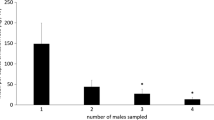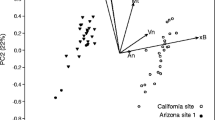Abstract
The number of western pine beetles,Dendroctonus brevicomis, trapped at the center of three 90 × 90-m plots was reduced during a 16-hr period after surrounding an attractive source ofexo-brevicomin, frontalin, and myrcene with 16, 48, or 168 sources of the same attractant. Compounds were released from the center of the plot at 1 mg/16 hr/compound, and from the surrounding sources at 4–280 mg/16 hr/compound. About half of these amounts was released between 1530 hr and 1930 hr, the period of peak beetle flight. No treatment differences were apparent in reduction of catch within the range of release rates and spacings tested. When compounds were released continuously from 168 stations for 17 days, catch at the center of a plot was generally lower than catch before or after this period, but fluctuated daily. More beetles were caught on traps hung on ponderosa pines within a plot and the number of these traps catching beetles was greater when compounds were released from all stations than from only the center station. Beetles caught on traps were attracted into the plots from the surrounding forest, but appeared to be dispersed within the plot when compounds were released from many stations.D. brevicomis attacked at least 91 trees in the plots, of which 25 were killed during two summers.
Similar content being viewed by others
References
Bedard, W.D., andBrowne, L.E. 1969. A delivery-trapping system for evaluating insect chemical attractants in natureJ. Econ. Entomol. 62:1202–1203.
Bedard, W.D., Wood, D.L., Tilden, P.E., Lindahl, K.Q., Jr., Silverstein, R.M., andRodin, J.O. 1980. Field responses of the western pine beetle and one of its predators to host-and beetle-produced compounds,J. Chem. Ecol. 6:625–641.
Furniss, M.M., Clausen, R.W., Markin, G.P., McGregor, M.D., andLivingston, R.L. 1981. Effectiveness of Douglas-fir beetle antiaggregative pheromone applied by helicopter. USDA For. Serv. Gen. Tech. Rep. INT-101. 6 pp. Intermountain For. and Range Exp. Stn., Ogden, Utah.
McLaughlin, J.R., Shorey, H.H., Gaston, L.K., Kaae, R.S., andStewart, F.D. 1972. Sex pheromones of Lepidoptera. XXXI. Disruption of sex pheromone communication inPectinophora gossypiella with hexalure.Environ. Entamai. 1:645–650.
Richerson, J.V., McCarty, F.A., andPayne, T.L. 1980. Disruption of southern pine beetle infestations with frontalure.Environ. Entomol. 9:90–93.
Shorey, H.H., Kaae, R.S., Gaston, L.K., andMcLaughlin, J.R. 1972. Sex pheromones of Lepidoptera. XXX. Disruption of sex pheromone communication inTrichoplusia ni as a possible means of mating control.Environ. Entomol. 1:641–645.
Tilden, P.E., Bedard, W.D., Wood, D.L., andStubbs, H.A. 1981. Interruption of response ofDendroctonus brevicomis to its attractive pheromone by components of the pheromone.J. Chem. Ecol. 7:183–196.
Tilden, P.E., Bedard, W.D., Lindahl, K.Q., Jr., andWood, D.L. 1983. TrappingDendroctonus brevicomis: Changes in attractant release rate, dispersion of attractant, and silhouette.J. Chem. Ecol. 9:311–321.
Author information
Authors and Affiliations
Additional information
Coleoptera: Scolytidae.
Trade names are mentioned solely for information. No endorsement by the U.S. Department of Agriculture is implied.
Rights and permissions
About this article
Cite this article
Tilden, P.E., Bedard, W.D., Wood, D.L. et al. Interruption of response ofDendroctonus brevicomis to attractive pheromone by release of pheromone at several rates and spacings. J Chem Ecol 13, 85–97 (1987). https://doi.org/10.1007/BF01020353
Received:
Accepted:
Issue Date:
DOI: https://doi.org/10.1007/BF01020353




